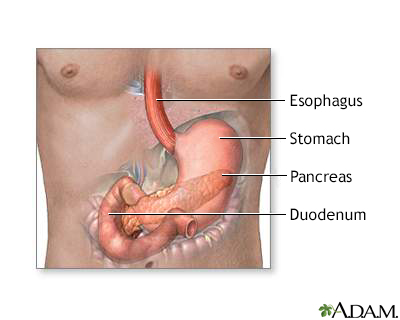Secretin stimulation test
Pancreatic function test
The secretin stimulation test measures the ability of the pancreas to respond to a hormone called secretin. The small intestine produces secretin when partially digested food from the stomach moves into the area.
Images

How the Test is Performed
The health care provider inserts a tube through your nose and into your stomach. The tube is then moved into the first part of the small intestine (duodenum). You are given secretin through a vein (intravenously). The fluids released from the pancreas into the duodenum are removed through the tube over the next 1 to 2 hours.
Sometimes, the fluid can be collected during an upper GI endoscopy.
How to Prepare for the Test
You will be asked to not eat or drink anything, including water, for up to 12 hours before the test.
How the Test will Feel
You may have a gagging feeling as the tube is inserted.
Why the Test is Performed
Secretin causes the pancreas to release a fluid that contains digestive enzymes. These enzymes break down food and help the body absorb nutrients.
The secretin stimulation test is done to check the digestive function of the pancreas. The following diseases may prevent the pancreas from working properly:
In these conditions, there may be a lack of digestive enzymes or other chemicals in the fluid that comes from the pancreas. This can reduce the body's ability to digest food and absorb nutrients.
Normal Results
Normal value ranges may vary slightly depending on the lab doing the test. Talk to your provider about the meaning of your specific test results.
What Abnormal Results Mean
Abnormal values may mean that the pancreas is not working properly.
Risks
There is a slight risk of the tube being placed through the windpipe and into the lungs, instead of through the esophagus and into the stomach.
Related Information
Cystic fibrosisPancreatic cancer
Chronic pancreatitis
References
Pandol SJ. Pancreatic secretion. In: Feldman M, Friedman LS, Brandt LJ, eds. Sleisenger and Fordtran's Gastrointestinal and Liver Disease. 11th ed. Philadelphia, PA: Elsevier; 2021:chap 56.
Semrad CE. Approach to the patient with diarrhea and malabsorption. In: Goldman L, Cooney KA, eds. Goldman-Cecil Medicine. 27th ed. Philadelphia, PA: Elsevier; 2024:chap 126.
Siddiqi HA, Rabinowitz S, Axiotis CA. Laboratory diagnosis of gastrointestinal and pancreatic disorders. In: McPherson RA, Pincus MR, eds. Henry's Clinical Diagnosis and Management by Laboratory Methods. 24th ed. Philadelphia, PA: Elsevier; 2022:chap 23.
BACK TO TOPReview Date: 10/30/2024
Reviewed By: Jenifer K. Lehrer, MD, Gastroenterologist, Philadelphia, PA. Review provided by VeriMed Healthcare Network. Also reviewed by David C. Dugdale, MD, Medical Director, Brenda Conaway, Editorial Director, and the A.D.A.M. Editorial team.

Health Content Provider
06/01/2025
|
A.D.A.M., Inc. is accredited by URAC, for Health Content Provider (www.urac.org). URAC's accreditation program is an independent audit to verify that A.D.A.M. follows rigorous standards of quality and accountability. A.D.A.M. is among the first to achieve this important distinction for online health information and services. Learn more about A.D.A.M.'s editorial policy, editorial process and privacy policy. A.D.A.M. is also a founding member of Hi-Ethics. This site complied with the HONcode standard for trustworthy health information from 1995 to 2022, after which HON (Health On the Net, a not-for-profit organization that promoted transparent and reliable health information online) was discontinued. |
The information provided herein should not be used during any medical emergency or for the diagnosis or treatment of any medical condition. A licensed medical professional should be consulted for diagnosis and treatment of any and all medical conditions. Links to other sites are provided for information only -- they do not constitute endorsements of those other sites. © 1997- 2025 A.D.A.M., a business unit of Ebix, Inc. Any duplication or distribution of the information contained herein is strictly prohibited.
